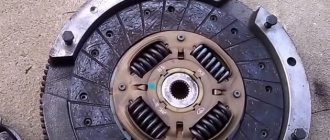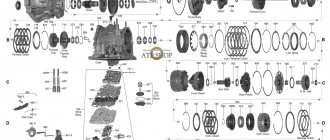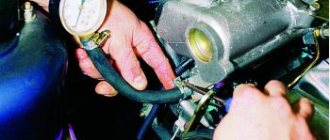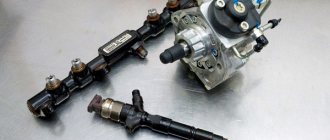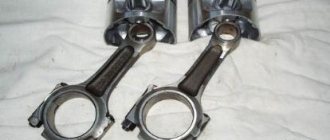Breather device, where is it located?
To better understand the causes of the malfunction, it is useful to understand the design of the unit. As a rule, it looks the same for all manufacturers - in the form of two fittings coming out from under the oil trap in the valve cover. There are large and small breathers.
Large breather
When crankcase pressure increases, which is common in used vehicles, large amounts of gases escape through the pan. The internal combustion engine crankcase is directly connected to the upper part of the valve mechanism by a special tube. The breather mechanism equalizes the pressure difference by admitting outside air.
Regardless of the location, the purpose of the device is the same. It is noteworthy that the valve has an additional filter that does not allow dirt, water and excess particles to penetrate inside the internal combustion engine along with atmospheric air. The reasons and how to eliminate the formation of excess crankcase gases are described below.
Cleaning the crankcase ventilation system of VAZ 2108, 2109, 21099 cars
Contamination of the engine crankcase ventilation system on VAZ 2108, 2109, 21099 vehicles leads to a decrease in the efficiency of removing crankcase gases from it into the carburetor and further into the afterburning cylinders. As a result, the pressure in the crankcase increases.
The engine oil located there under pressure begins to be expelled through the crankshaft and camshaft seals, the valve cover gasket, its oil filler plug, and is thrown into the air filter housing. As a result, the carburetor becomes clogged, the engine begins to “trouble” and stall, the spark plugs become covered with soot, power and throttle response decrease, engine oil waste increases, etc.
Similar symptoms may occur when the engine piston group wears out (rings, pistons, cylinders), but since you need to start looking for the cause of the malfunction from the simplest, you should first clean the ventilation system, since this is less expensive and problematic than a major engine overhaul. The piston can then be checked by measuring the compression in the engine cylinders.
The procedure for cleaning the crankcase ventilation system of an engine with a Solex carburetor 2108, 21081, 21083 and similar ones
We sequentially remove and clean the elements of the small and large branches of the crankcase ventilation. For cleaning we use acetone or gasoline, a toothbrush, and copper wire. We blow with compressed air from a pump or compressor, simultaneously controlling the ease of its passage.
There is no need to remove it from the engine, just clean the crankcase gas exhaust channel from contaminants with a brush soaked in gasoline. Blow with compressed air. See photo above.
— Cleaning the large exhaust hose
We disconnect it from the pipe on the engine valve cover and from the breather. We wash it with gasoline (pour it inside and shake it, then pour it with water). Blow with compressed air.
the large exhaust hose of the crankcase ventilation system of VAZ 2108, 2109, 21099 cars is removed from the pipe on the cover and the breather
— Clean the crankcase gas exhaust hose into the cavity of the engine air filter housing
Disconnect the hose from the fitting on the valve cover. Remove the air filter housing. Disconnect the hose from the body. We clean the hose itself and the pipe under it on the air filter housing.
hose for exhausting crankcase gases into the engine air filter housing and its pipe on the removed and inverted air filter housing
— Clean the crankcase gas exhaust hose into the throttle body
Disconnect it from the fittings on the carburetor and on the valve cover. We spill, we blow.
To access the oil separator, you must remove the engine valve cover. After unscrewing the two 10mm bolts, disconnect the oil separator from the inner surface of the valve cover. We wash the oil separator with gasoline. Blow with compressed air. Refer to "Cleaning the Oil Separator for Engines 2108, 21081, 21083".
— We clean the fitting and channel with a calibrated hole in the Solex carburetor
Can be cleaned using copper wire without removing the carburetor from the engine. After cleaning, blow with compressed air. In case of severe contamination, the carburetor will have to be removed to clean them.
cleaning the channel and crankcase gas outlet fitting behind the throttle on a Solex carburetor using copper wire
After cleaning, we install all the elements of the engine crankcase ventilation system back, if necessary, replacing the hose clamps or the hoses themselves, if damaged. During the operation of the car, we check whether the oil leakage under the oil seals and seals has stopped. If not, check the serviceability of the engine piston group.
Notes and additions
— On engines 2111 of VAZ 2108, 2109, 21099 cars, cleaning the ventilation system is done in the same way, taking into account the fact that there is no carburetor, but a throttle body with a fitting for a thin hose of the small branch of crankcase ventilation from the valve cover.
— After cleaning the ventilation system on a carburetor engine, it makes sense to clean the air jets of the GDS carburetor of the Solex carburetor and replace the filter element of the engine air filter.
More articles on engines of VAZ 2108, 2109, 21099 cars
— Engine crankcase ventilation system 2108, 21081, 21083, diagram
— Engine crankcase ventilation system 2111, diagram
— Burnt out valve, signs, causes
Reasons why the engine is breathing
First, let's find out why the engine is breathing. This happens for two main reasons, which are given below.
The problem is always accompanied by characteristic signs: oil leaks and burning, blue smoke from the filler neck on a warm engine.
Indirect reasons include incorrect selection of oil. Low-quality motor oil steams, burns out and leaves waste. The general condition of the diesel unit is unfavorable - decreased compression, fog under the hood, excessive vacuum in the intake tract.
Occurrence of rings
A common cause of this phenomenon is a problem with the piston rings. In this case, part of the exhaust gases enters the engine crankcase. Gases at increased pressure begin to look for a way out. As a result, you can see the exhaust flying out of all the cracks. At the same time, an increase in oil consumption is observed. Part of it squeezes out through the dipstick
, the other part, entering the combustion chamber, burns out along with the fuel. In fact, this reason is a consequence of a malfunction.
Often such a problem can be indicated by a lit “check” on the dashboard. It's all about changing the composition of the exhaust gases. Therefore, if such readings on the dashboard coincide with the engine breath, you should immediately check the condition of the engine. To do this, check the compression. If in at least one “boiler” the indicator is less than 11 points, then you will have to disassemble the motor and fix the problem.
After removing the pistons, you need to inspect the rings. Maybe they just lay low
. To fix the problem, remove the rings. This must be done very carefully; if you break one ring, you will have to buy the whole set. After removing them, sand the inner surface with sandpaper. Take a couple of metal blades, fasten them together and remove the corrosion from the grooves. Then put the rings in place (make sure that the locks are not located on top of each other) and check how they fit into the cylinder. If the piston and rings are loose there, you will have to install new rings.
Cylinder-piston group
. There is a problem, but is it not related to ventilation and rings? Most likely, the car's cylinder liners are damaged. To eliminate the problem, grind the cylinders and install new pistons with repair dimensions.
Conclusion
. Sometimes drivers encounter strange smoke emerging from the engine. This usually results in increased oil consumption. That's why many car enthusiasts wonder why the engine is breathing. The cause of this phenomenon may be problems with increased wear of some engine parts, and as a consequence, you may receive a major overhaul.
Source: autoflit.ru
What not to do
It is wrong to solve the problem by disconnecting the crankcase ventilation tube from the valve cover and leading it under the car - this is only a last resort measure to help you get to the garage or a nearby service center. The fact is that the hose will begin to collect dust, sucking in dirty street air when the pistons operate. Such savings on a full system restoration will only worsen the situation. Everything can end with a complex overhaul of the unit, since the CPG, crankshaft and other components quickly wear out.
It is advisable to inspect the breathers every 10-15 thousand kilometers, especially if the car was often operated off-pavement. You should also pay attention to these details when you detect an oil leak on the internal combustion engine. This is done by removing the device and inspecting the movement of the cover. It should move freely without sticking.
Source
System assembly
After cleaning the breather is completed, you need to assemble the crankcase ventilation system. When installing the glass in place, you need to carefully align its tube with the seat. Next, a pin is screwed in, which is tightened with an open-end wrench to 13.
Before installing the breather cover, a paronite oil pan gasket is placed on the seat, which prevents gases from escaping from the system. After each disassembly of the breather, it is better to replace it, additionally treating the seating area with heat-resistant silicone, which will increase the reliability of the connection. The breather is put with a cut on the hole in the glass tube to form a channel for installing the oil level dipstick. A washer and a special nut with a rounded head are put on the stud, which is clamped with a wrench; when tightening, you do not need to pinch the nut so as not to strip the thread.
After this, the hose is put on the carburetor and the main hose. It must be inspected first, and if it is cracked, it is better to replace it with a new one to avoid excess air being sucked in. At the entrance to the air filter or in the hose itself, experts advise placing a special metal brush called a flame arrester.
It retains oil well, which may be contained in crankcase gases and enter the air filter, clogging it. As a result, the quality of the air-fuel mixture decreases and engine stability is lost. This is especially important for cars with high engine mileage; used oil and emulsion are deposited on it and flow back into the crankcase. When choosing this part, it is better to consult with specialists so that the wire from which it is made is of high quality and does not break, getting into the crankcase.
Troubleshooting
Read more: How to test the starter solenoid relay with a multimeter
Helpful advice! To distinguish stuck rings from a burnt-out valve, it is enough to perform several manipulations. After checking the compression in the cylinders, determine the cylinder with the lowest value. Then inspect the spark plug of this cylinder; if the rings are lodged in this cylinder, the spark plug will be covered with a thick oil layer. If the valve is burnt out, the spark plug will appear normal without any major abnormalities.
Finally…
The problem of oil escaping through the breather worries many motorists and causes a lot of trouble, but if the problem is detected in a timely manner and the right approach is taken, serious consequences can be avoided. It is important to ensure that the oil level is normal; as soon as you find that the engine is taking oil, monitor its level and constantly monitor it so that it does not fall below the permissible level. Also pay attention to the breather and filter; oil on the air filter in large quantities also does not bode well. Regularly monitor the condition of the engine and all systems, and also promptly correct any malfunction. This will save you from engine overhauls and unnecessary waste.
Any type of car engine has a complex structure. It includes various systems and mechanisms that interact with each other. To ensure the removal of gases formed in the internal cavities of the power unit, the diesel engine is equipped with an effective ventilation system.
Way to solve the problem
When starting to clean the breather, first of all we look for a device under the hood and remove the air filter from it. Before doing this, de-energize the car by disconnecting the negative terminal from the battery and turning off the ignition. There is an intake manifold under the filter - we will also dismantle it. After this, you can see the prompter itself - as a rule, its cover is secured with two bolts, which will have to be unscrewed. After removing the cover, the oil bumper will become visible - it is secured with a pin.
Read more: What is a lawn according to the law?
It is necessary to unscrew the nut located on the stud, but there is no need to remove the stud itself, because it will be difficult to put it back without dismantling the pan. We make a cleaning rod out of wire, which we use to clean the tube. There is a brush on the breather cover to extinguish the flame - we clean that too.
All that remains is to check the device. We start the engine, remove the plug from the oil filler neck, and cover the neck itself with your palm. You can feel with your hand whether there is pressure. Then the assistant should press on the gas until the speed reaches 100-130 km/h and check the compression again by applying the palm of his hand. A little pressure should already be felt.
To avoid problems with the release of working fluid through the prompter, it is necessary to constantly monitor its level. It is also important to pay attention to checking the filter and gearbox.
Owners of old domestic cars, after several years of ownership, can easily write a directory of “diseases” of a particular car model. One of these “sores” is an engine malfunction in which engine oil is squeezed out through the breather. This phenomenon is most often simply called by people: “oil is driven through the breather” or “oil is thrown out through the breather.”
The problem is quite unpleasant and is accompanied by a large number of engine-related problems. It is this problem, as you probably already guessed, that we will talk about in this article. You will learn why oil comes out of the breather and how to solve this problem. Go.
As a rule, the problem occurs with the onset of cold weather, the breather freezes and the oil is squeezed out. This manifests itself in the form of oil drips that are visible from the outside of the engine. Failure to respond to this phenomenon in a timely manner can lead to serious engine damage.
